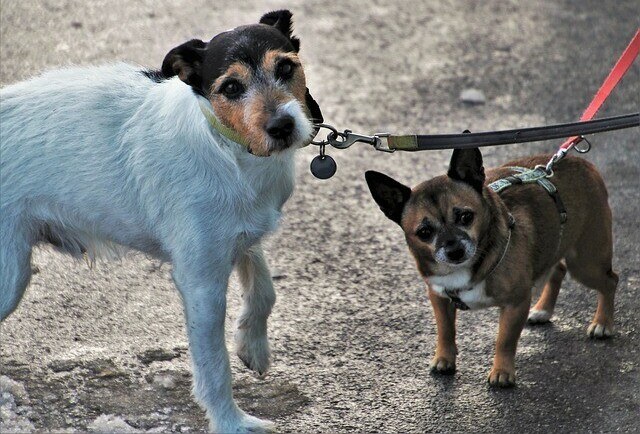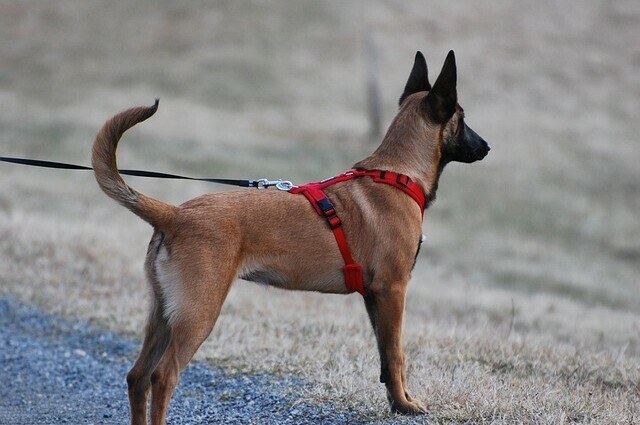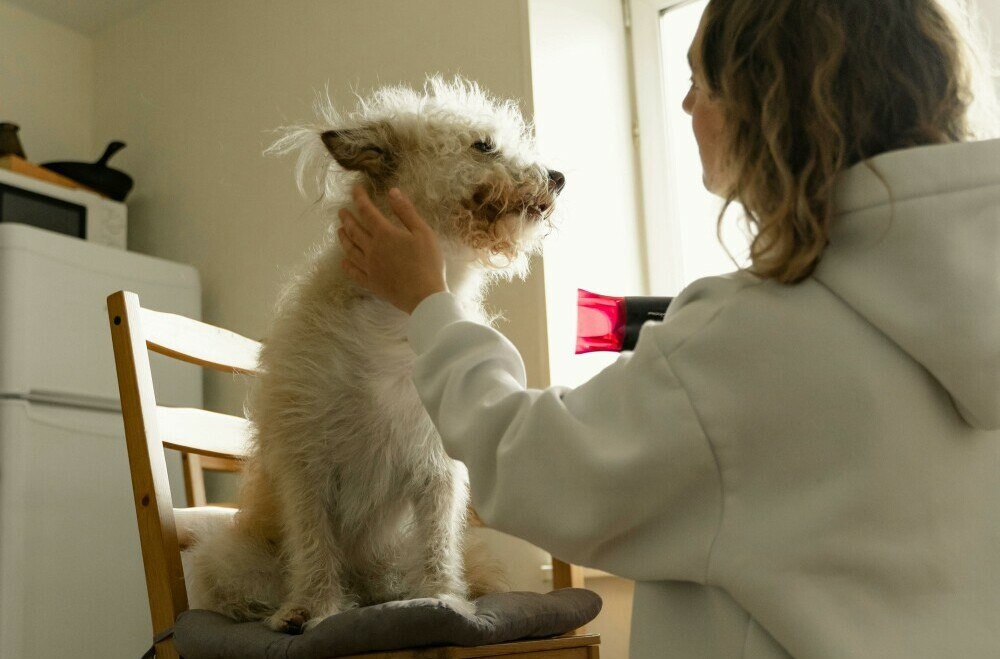This post contains affiliate links, which means I may earn money from products and services you purchase through my links.
Have you ever wondered if you should take your pet for a stroll as you gaze out the window with raindrops tapping against the glass? Our comprehensive guide, “The Ultimate Guide to Walking Pets in the Rain,” covers everything from nose to tail.
We’ll cover all the essential information to ensure your four-legged friend is content, secure, and dry on those rainy walks.
We have the scoop on everything from the best pet protection gear to walking safely outside in the rain. Since walking pets is essential to good health, why let a little rain get in the way?

Preparation for Walking Pets in the Rain
We’re preparing you in this part to take on those wet walks like a pro. Everything from gathering the appropriate gear to checking the clouds overhead will be covered. Let’s be sure you’re ready for anything the weather throws at you, whether you are an experienced dog walker or just starting!
Gathering Necessary Gear for Walking Pets
The right equipment can make a big difference when preparing for pets walking on wet days. The following supplies will help you keep your pet comfortable and weatherproof:
Waterproof Leash: Choose a waterproof leash made from materials like nylon or rubber to prevent it from getting water-logged and heavy during your walk.
Raincoat for Your Pet: Pets can benefit from a waterproof raincoat that fits snugly but allows movement, keeping them dry and minimizing mess upon return home.
Towel or Blanket: A towel or blanket is essential for pet drying after walks, as it helps clean fur and paws, preventing water and mud from entering your home.
Waterproof Footwear (Optional): Booties help pets keep their paws dry and protected from cold, wet surfaces, and if tolerated, consider investing in a pair.
Reflective Gear: Rain often reduces visibility, so wear reflective gear such as a vest or collar to ensure visibility to passing vehicles.
Waste Bags: Pack waste bags for pet walks, as they will continue to poop regardless of the weather; be prepared to clean up after your pet.
Assessing Weather Conditions for Walking Pets

When it’s raining cats and dogs outside, take a moment to assess the weather conditions. Here’s what to consider before venturing out:
The intensity of Rain: Heavy downpours can pose safety risks, such as reduced visibility and slippery surfaces, so wait for it to ease before leaving.
Temperature: Keep your pet indoors if the temperature outside is too cold because of the rain, or if there’s a risk of chilling them.
Thunder and Lightning: Stay indoors for thunderstorms and lightning, as they can be frightening for pets and pose significant danger in open areas.
Wind: Winds can worsen the effects of rain, making it colder and uncomfortable. High winds can also cause debris to fly around, posing hazards to you and your pet.
Duration of Rain: Consider the expected duration of rain, whether it’s a passing shower and you can wait or a full day, and adjust your plans accordingly
Planning Route and Timing for Walking Pets
The experience of walking your pet in the rain can be greatly improved by carefully considering your route and timing. The following advice will help you get the most out of your walk on a rainy day:
Choose Sheltered Paths: Choose routes with shelter, like tree-lined streets or covered walkways, to keep you and your pet drier and more comfortable during your walk.
Avoid Busy Streets: Rainy days can reduce visibility, making it difficult for drivers to see pedestrians and pets. It’s recommended to avoid busy streets and opt for quieter residential areas
Time it Right: Time your walk for light rain or weather breaks to minimize exposure to elements and increase enjoyment for you and your pet.
Check for Hazards: Before starting, thoroughly inspect your chosen route for hazards like large puddles, slippery surfaces, or fallen branches. Steer clear of areas that pose risks to you and your pet.
Shorten the Route: Shorten your walking route during inclement weather to reduce rain time and the risk of getting soaked, benefiting you and your pet.
Safety Considerations for Walking Pets in the Rain
Ensure everyone is safe and sound when walking your pet in wet weather. To do this, there are a few key factors to consider. This section will cover every aspect of walking your pet in the rain, from identifying potential hazards to putting safety measures in place to keep you both safe.
Is it Safe Walking Pets in the Rain?
When it’s raining hard, you might wonder if you can walk your dog safely. Here’s what you need to know:
Risk of Slippery Surfaces: Wet pavement and sidewalks can become slippery, increasing slips and falls for humans and dogs. Exercise caution on steep inclines or poorly drained surfaces.
Visibility Concerns: During rainstorms, reduced visibility can be challenging for drivers and pedestrians who might not see you walking. Wear brightly coloured or reflective gear to improve visibility and reduce accident risks.
Potential for Illness: Prolonged rain exposure can weaken a dog’s immune system, increasing susceptibility to illnesses. Dry and warm up your pet after walks in the rain.
Electrical Hazards: Avoid puddles and standing water, as they may conceal electrical hazards like downed power lines.
Bacterial Contamination: Rainwater can release harmful pollutants into puddles and water sources, so it’s advisable to avoid letting your dog drink from puddles and bring a clean, portable, fresh water bowl.
Tips for Ensuring Safety during Rainy Walks
A few basic guidelines can go a long way toward ensuring your pet’s safety when going on rainy walks:

Use a Secure Leash and Collar: Ensure your dog’s leash and collar are in good condition and securely fastened before leaving, as a sturdy leash helps maintain control, especially in lightning- or thunder-spooked situations.
Stay Visible: Wear brightly coloured or reflective gear for both you and your pet to improve visibility, especially in low-light or heavy rain, ensuring easy visibility for passing vehicles and pedestrians.
Avoid Standing Water: Keep your dog on a short leash and guide them away from puddles and standing water, as they may contain hazards like sharp objects or bacteria.
Watch for Signs of Discomfort: Observe your dog’s body language during walks, and respect their signals if uncomfortable, shivering, or reluctant, as prolonged exposure to rain and cold can cause hypothermia or other health issues.
Dry Off Thoroughly: After walking, dry the pet thoroughly with a low-heat towel or low-setting hairdryer, focusing on the paws, ears, and belly for moisture retention and skin irritation.
Monitor for Illness: Lethargy, coughing, sneezing, or other symptoms following a rainy walk may indicate a cold or respiratory infection, prompting a visit to the veterinarian.
Protecting Pets from Rainy Weather
When the rain starts falling, it’s time to gear up and protect our pets from the weather. We’ll cover all you need to know to ensure your pets are comfortable, dry, and safe on those rainy-day walks. We have everything you need, from the appropriate equipment to crucial after-walk-care.
Should Dogs Wear Raincoats or Rain Boots when Walking?
Whether your dog should wear raincoats or rain boots comes up frequently when protecting them from rainy weather. Here are some things to consider:
Raincoats: Raincoats, particularly for shorter or cold breeds, provide dry fur and minimize mess. Choose waterproof materials for snug fit and comfortable movement.
Rain Boots: Even though considered cute, rain boots may not be suitable for all dogs due to discomfort or difficulty walking. However, they can offer additional protection from moisture, chemicals, and debris in rough terrain or chemical-treated sidewalks.
Consider Your Dog’s Preferences: The choice between a raincoat or boots for your dog depends on their individual preferences and needs and should be gradually introduced and positively reinforced.
Assess the Weather Conditions: When choosing rain gear for your dog, consider the intensity and duration of your walk. Drizzle or extended walks may suffice without extra protection, ensuring their comfort and safety.
Importance of Drying Off After Walking Pets

It’s practical to dry off your pet after a rainy stroll but it’s vital for their health and welfare. This is why it’s so important to dry off:
Preventing Skin Irritation: Excess moisture in pet fur can promote bacteria and fungi growth, causing skin irritation and infections. Thorough drying removes excess moisture and prevents these issues.
Avoiding Chilling: Drying pets helps regulate body temperature, prevents chills, and prevents serious health issues. Like humans, pets can get chilled by being kept wet for too long in cooler temperatures.
Minimizing Odours: Drying your pet promptly after rainy walks can help minimize unpleasant odours and keep them fresh and clean.
Preventing Tangling and Matting: Drying off wet fur prevents tangling and matting, discomfort and pain for pets, ensuring their coat looks and feels its best.
Maintaining Hygiene: Drying off wet fur helps maintain cleanliness and prevents health issues, as it removes dirt, debris, and contaminants that can clog your pet’s pores.
Health Concerns and Risks
Even while walks on rainy days can be rejuvenating for you and your pet, you need to be mindful of any possible health risks that may be present in those droplets. We’ll cover what is necessary to keep your pet safe and healthy when they brave the weather.
Can Dogs Get Sick Walking in the Rain?
Are you worried your pet can get a cold from walking in the rain? Here’s what you need to know:
Myth vs. Reality: Dogs don’t catch colds in the same way humans do, as their respiratory systems differ. However, cold and damp conditions can weaken their immune systems, increasing their susceptibility to colds.
Risk of Respiratory Infections: Exposure to rain and cold temperatures increases dog respiratory infections due to moisture irritation, causing symptoms like coughing, sneezing, nasal discharge, or lethargy.
Risk of skin irritation or bacteria: Drying your dog thoroughly after rainy walks is crucial for their health, as moisture trapped in their fur can cause skin irritation, bacterial growth, and discomfort.
Other Health Considerations: Besides respiratory infections, walking in the rain exposes dogs to slipping and parasites. Preventive measures like leash use and avoiding puddles can minimize these risks.
Signs of Illness to Watch for After Rainy Walks
It’s important to watch out for any signs of illness after walking pets in the rain. Here are some important symptoms to watch out for:
Coughing or Sneezing: A persistent cough or frequent sneezing in your dog after a rainy walk may indicate a respiratory infection or irritation from cold, damp air exposure.
Nasal Discharge: Excessive or discoloured nasal discharge in your dog may indicate a respiratory infection or allergy, so monitor for changes in colour or consistency.
Lethargy or Weakness: If your dog seems unusually tired or weak after a rainy walk, look for signs of illness or discomfort, and contact your veterinarian if any significant changes occur.
Loss of Appetite: A sudden loss of appetite or reluctance to eat may indicate health issues, so monitor your dog’s eating habits and contact your veterinarian if they refuse food for more than a day.
Vomiting or Diarrhea: If your dog vomits or has diarrhea after a rainy walk, it may indicate gastrointestinal upset or harmful ingestion. Monitor their symptoms and consult a veterinarian if they persist or worsen.
Changes in Drinking or Urination: Pay attention to your pet’s drinking and urination habits, as these behaviours could indicate health issues, including dehydration, urinary tract infections, or kidney problems.
Difficulty Breathing: If your dog is experiencing breathing difficulties, it may indicate a serious respiratory or other health issue, so seek immediate veterinary attention.
Temperature Regulation: Ensure your pet can regulate their body temperature effectively after rainy walks. Watch for signs of overheating or hypothermia, such as excessive panting, shivering, or seeking out warm or cool areas.
Post-Walk Care for Pets in the Rain
Giving your pet some TLC ensures their happiness, health, and comfort after you have weathered the rain. Everything you need to know about drying and cleaning up after walking pets will be covered in this section.
Cleaning and Drying Techniques after Walking Pets
Here are some practical methods to keep your cat comfortable and healthy when cleaning and drying them off after wet walks:
Towel Drying: Gently pat your pet’s fur dry using a clean towel, focusing on areas with moisture retention like the belly, paws, and ears, avoiding vigorous rubbing.
Hair Dryer (Optional): Use a low-heat hair dryer with your pet, keeping it safe from them and avoid using high heat to prevent discomfort or overheating.
Brushing: Using a brush after drying your pet helps remove tangles and mats, maintain a neat coat, promote air circulation, and prevent skin irritation.
Paw Cleaning: Ensure your pet’s paws are clean and free from dirt, mud, and debris during rainy walks, using a damp cloth to prevent irritation and maintain their health.
Ear Cleaning: To prevent ear infections in pets, gently wipe their ears with a damp cloth after walks, avoiding insertion into the ear canal and only cleaning the outer flap and visible parts.
Monitoring for Moisture: Monitor pets for moisture, especially in thick fur or skin folds, to prevent bacterial growth and skin irritation, and ensure complete dryness before daily care.
Conclusion
You must understand the importance of proper care and attention for your pet during rainy day walks. Following these tips ensures safety, health, and happiness for you both.
Prioritizing your pet’s comfort and safety is necessary, whether navigating puddles or facing storms, as every step you take plays a vital role in their well-being.
Rainy day walks can be cherished moments of bonding and adventure for you and your pet and will give you confidence in handling the weather.
How about you? Do you love walking pets in the rain, or is it just something you feel is necessary? We’d love to know your thoughts.

We love to travel. For our trip to Mexico, we were able to save money by house sitting, which was something completely new to us. If this is something that interests you, then check out TrustedHousesitters or HouseSitMexico (be sure and use Code thetr6210d47b7cc90 for discount). We hope you visit often.